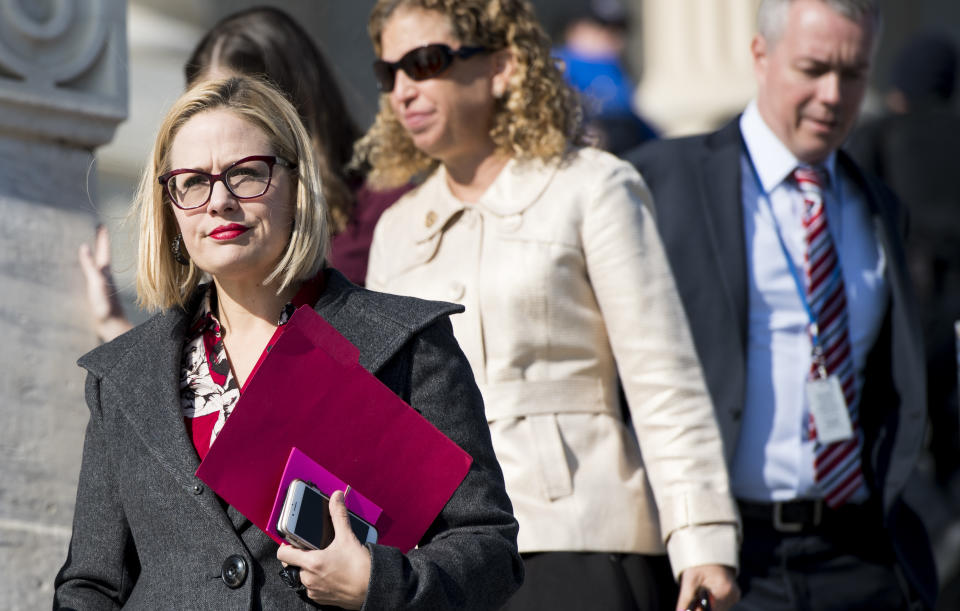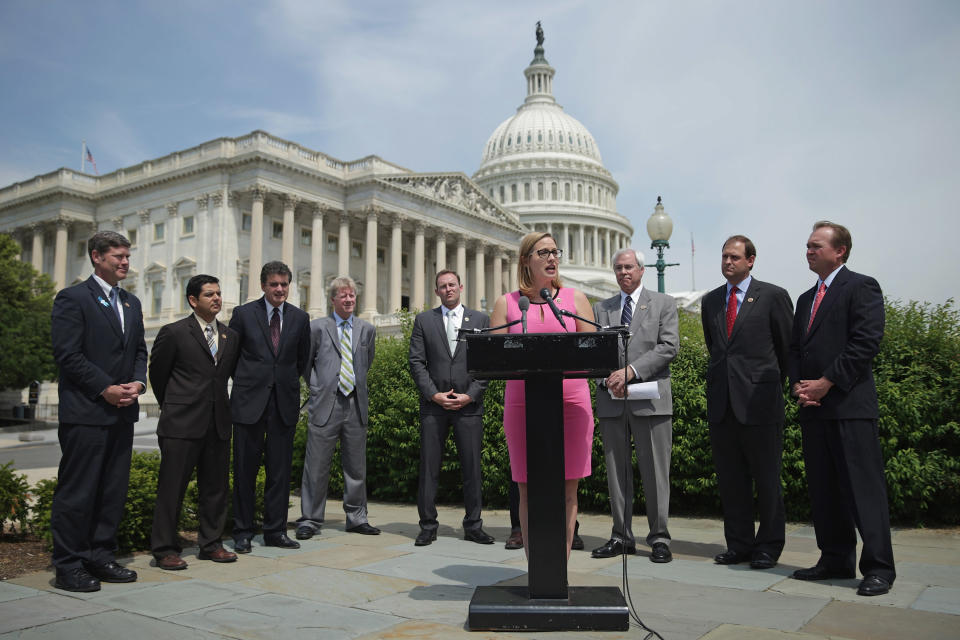As Democratic rage builds, Kyrsten Sinema tries a different approach. Will Arizona voters buy it?

Ask any Democratic activist in Washington, D.C., what they think of centrism — or moderation, or bipartisanship — and they’ll probably tell you the same thing.
So pointless. So naïve. So passé.
In an age of fake news and choose-your-own-reality Facebook feeds, of Infowars and Breitbart, of a Republican Party that lurches further right with each election and a president whose agenda seems to consist solely of sledgehammering his predecessor’s legacy, the only sane response, these Democrats have concluded — and the only real way to regain power, starting with the 2018 midterms — is to veer left with similar ferocity and “resist” at every turn.
“The problem with the Democratic Party is that they have been trying to convert Republican voters or cajole white working-class voters,” Aimee Allison, president of Democracy in Color, recently told the Washington Post, neatly summarizing the conventional wisdom among progressives. “The job of Democrats this week, in 2018 and in 2020, is to excite the base.”
And yet 2,300 miles away in Phoenix, the woman who is likely to become one of the Democratic Party’s marquee Senate nominees next year seems to have missed the memo entirely.
Meet Kyrsten Sinema: three-term congresswoman, lapsed Mormon, openly bisexual and nontheist trailblazer, Ironman triathlete — and, with $4.1 million on hand, the early frontrunner in the race to replace retiring Republican Sen. Jeff Flake, which is one of the few contests that will decide control of the world’s greatest deliberative body in 2019 and beyond.
Oh, and she is also one of the most moderate, bipartisan, aisle-crossing Democrats in all of D.C.

Sinema has yet to launch the media offensive that typically marks the start of campaign season; so far, she has only participated in a single profile, by the Arizona Republic. But in that article, Sinema made it clear that she will be campaigning in a manner that seems to clash dramatically with the prevailing view among progressives — namely, that if Democrats want to win back Congress, and eventually the White House, they should disregard America’s dwindling centrist bloc and focus instead on harnessing their own voters’ righteous anger at Trump.
Trump is “not a thing,” Sinema insisted when the Republic asked about her message. “[He’s] not a part of what I think my constituents are worried about or think about.”
Nor, she added, is partisanship. “It’s not about a party,” Sinema said. “It never is about party. It’s about putting people ahead of party. I don’t think party matters much to people.”
This sort of “No Labels” talk has a long history on the campaign trail. But what makes Sinema’s rendition unusual is not just that she’s delivering it at a time when such sentiments have never been less trendy among party regulars.
It’s that her record really does back it up.
As a result, Sinema’s candidacy raises a crucial question for the Democratic Party going forward: Is the only way to fight Trumpian fire with fire? Or, under the right conditions, can a less “resistant” approach still make sense? (Sinema doesn’t have the primary field to herself — rivals include Muslim-American attorney Deedra Abboud and tech entrepreneur Bob Bishop — but she is seen as the prohibitive favorite.)
“Elections aren’t one-size-fits all,” says Sacha Haworth, Sinema’s campaign spokeswoman. “The national narrative doesn’t decide these races. People don’t wake up in Arizona reading Twitter and think that’s the news of the day. So it’s crucial to keep your eye on the goal and continue being the sort of person your constituents elected you to be.”
It’s hard to overstate how resolutely centrist Sinema has remained during her nearly five years in Congress. She was one of just seven House Democrats to vote for a Republican-backed bill that would repeal the estate tax; one of just five House Democrats to vote for a Republican-backed bill that would bar the Federal Communications Commission from regulating broadband Internet rates; one of just six House Democrats to vote for a Republican-backed bill that would punish so-called sanctuary cities by withholding federal funds; and one of just seven House Democrats who voted to create a select committee to investigate the 2012 attack on the United States diplomatic compound in Benghazi, Libya. Sinema has also joined the GOP in voting for bills that would deregulate the banking industry, provide $1.6 billion for a border wall with Mexico, weaken Obamacare’s employer mandate and prevent Syrian and Iraqi refugees from being resettled in the United States until tighter vetting processes could be implemented. She has even voted against Nancy Pelosi for House minority leader — twice.

According to the Lugar Center, all of this makes Sinema is the fourth-most bipartisan member of the House, and the most bipartisan Democrat. Meanwhile, the data-driven website FiveThirtyEight had determined that the Arizona congresswoman has voted with President Trump 50 percent of the time — more often than all but one other House Democrat.
It’s early yet — Sinema is barely campaigning, and the national political class is barely paying attention — but already there are signs that progressives will have some problems with the candidate who’s likely to represent their side in the fight for one of 2018’s two most flippable Senate seats. (Right now, Democrats need two pickups to split the Senate 50-50 — and if Doug Jones defeats Roy Moore in the Alabama special election on Dec. 12, two would be enough to retake the chamber.)
“There are issues, murmurs within grassroots groups and the progressive community, the environmental community and others, including immigration advocates,” Arizona Rep. Raúl M. Grijalva, co-chairman of the Congressional Progressive Caucus, told the New York Times in October, explaining why he has been withholding his endorsement. “[There is] still a lot of resentment.”
These murmurs will only grow louder once the race ramps up — as will the inevitable arguments that by voting with Republicans and not only downplaying Trump but touting her meetings with him, Sinema could dampen enthusiasm among the base (particularly Arizona’s surging Hispanic population) without picking up the support of diehard Trump Republicans in return.
But it’s worth considering another scenario as well.
Arizona’s Ninth Congressional District was created after the 2010 census. Curving around central Phoenix to the north, east and south, it wound up containing almost the exact same mix of Republicans (34 percent), Democrats (31 percent) and independents (33 percent) as the state itself. Prior to declaring her candidacy in 2012, Sinema had once been a member of the Green Party; fond of designer shoes and glasses, she jokingly described herself as a “Prada socialist.” But Sinema campaigned (and later legislated) as a centrist who was “willing to work with anyone to get things done,” and after securing the new seat by a mere 10,000 votes, she has won reelection by widening margins (13 percentage points in 2014, and 22 percentage points two years later).

Sinema has reason to believe a similar strategy could work statewide. On the GOP side, staunch Trumper Kelli Ward will battle a more establishment-friendly Republican — such as Rep. Martha McSally of Tucson, an occasional Trump critic — in a divisive, expensive primary race that will almost certainly yank the party to the right. Meanwhile, Sinema will continue to target the familiar voters who’ve propelled her to victory in the Ninth,, which despite its even partisan split, voted for Clinton by 16 percentage points: independents and suburban, college-educated Republicans who are turned off by Trump but aren’t particularly turned on by the resistance.
This explains why Sinema recently told the New York Times that — in the Times’ paraphrasing — “a Democrat would have to campaign in a virtually nonpartisan way to win a Senate race” in Arizona, criticizing “national Democrats for moving too far to the left.”
“It’s irresponsible to promise a platform that you can’t deliver on,’’ Sinema added. “You’re not going to get free college.”
This also explains why, in the end, Arizona progressives may be unsatisfied. But amid what may be a national, anti-Trump wave election, would they really refuse to show up and vote in the one contest that could, more than any other, help them achieve their ultimate goal of halting President Trump’s agenda in its tracks?
It’s a question that will determine whether Sinema’s brand of centrism is, in fact, on the way out — or whether the reports of its death have been greatly exaggerated.
_____
Read more from Yahoo News:
Trump’s top aides, including one he fired, praise his loyalty
‘Pizzagate’ troll claims another victim as culture war rages on
Japanese defense in the age of North Korean missile successes
Divided by symbols, Americans see a ‘serious threat’ across the aisle
Photos: Wildfires in Southern California force thousands to flee



